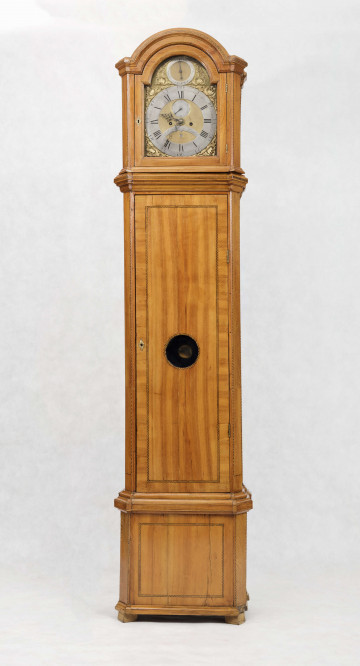
Floor cabinet clock
National Museum in Lublin
Part of the collection: Clocks
In 1656 the Dutchman Christiaan Huygens constructed the first clock with a pendulum regulator. It was a breakthrough for the further development of the art of watchmaking. Next to luxurious timepieces in metal frames, carved and gilded, which only wealthy people could afford, there appeared mechanisms placed in wooden cabinets that were much cheaper and more affordable for the general public. The cabinets have a simple form, often covered with black polish imitating precious ebony wood. The decoration is provided by metal accessories, especially the decorative handle, which creates an impressive finial and is also used for carrying. This form of sundial became particularly popular in the interiors of bourgeois houses, where comfort was valued, but too much ostentation was avoided, which is why Polish clockmakers were still using it in the 19th century.
The maker of this sundial was Jan Gotfryd Krosz (c. 1729-1813), who worked in Kraków between 1765 and 1795. He was a German by origin, but he settled permanently in Poland, in Kraków; he even made an effort – so difficult for a foreigner – to learn Polish. For many years, he served as an elder in the watchmakers' guild, of which he was a true benefactor. His efforts led to the separation of the watchmakers' guild from the locksmiths' guild, which earned him the gratitude of his fellow members. Many of his works have survived: table clocks, mantel clocks, wall clocks, carriage clocks, and their cases take various forms according to the changes of styles and fashions. Some bear the signature 'horloger du Roy' (royal watchmaker). It was not just an empty title, as, according to preserved documents, Krosz did indeed deliver clocks to the royal court.
Barbara Czajkowska
Author / creator
Dimensions
cały obiekt: height: 27,5 cm, width: 46 cm
Object type
goldsmith's art
Technique
French polish coating
Material
brass, steel, wood, glass
Creation time / dating
Creation / finding place
Owner
The National Museum in Lublin
Identification number
Location / status

National Museum in Lublin

1701 — 1800
National Museum in Lublin

1840 — 1850
National Museum in Lublin
DISCOVER this TOPIC
Castle Museum in Łańcut
DISCOVER this PATH
Educational path